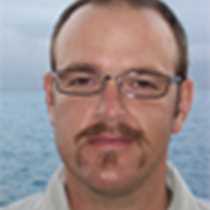Turquoise was our color of the morning as we found ourselves anchored at Gardner Bay. The sandy shallow bottom was evident as the reflection of the rising sun reached the bottom. Española is one of the oldest islands in the Galápagos. While it can appear quite drab, there is an incredible density of life to be found here.
After obtaining our snorkeling equipment we head out to explore the underwater realm along the coast of a small islet called Gardner. Razor surgeonfish in large aggregations cover the bottom searching for sustenance. Mexican hogfish follow closely trying to gain a morsel or two. Young Galápagos sea lions decide that we are worthy of investigation, blowing bubbles at us and swimming circles around us. From the beach, newborn sea lion pups play in the splash zone as they wait for their mothers to return from foraging. A pup, only a couple days old, smells each sea lion on the beach hoping to find its mother but, unfortunately, it is rejected at every turn.
Española mockingbirds flit along the beach and land not only close to us but also on top of our gear that is left on the beach. Squawks are heard as these birds protect their territories from other mockingbird “clans.”
After a short navigation, the National Geographic Endeavour anchors at Punta Suarez, the southernmost visitor site in the archipelago and the first one to be affected by the cold Humboldt Current that comes from sub-Antarctic waters along the coast of South America. Waved albatrosses come upon Española Island as they follow the rich waters of this current. This island has become a nesting colony, which limits the range of waved albatrosses to this area and nowhere else on earth.
Red-billed tropicbirds screech as they fly along the cliffs searching for nesting areas. As we walk along this boulder path we are careful not to step on the residents as they “litter” the path. Nazca and blue-footed boobies nest on the path or close to the southern cliffs. Brightly colored marine iguanas also find this to be an acceptable place to rest between grazing sessions in the intertidal zone. We are able to stop and sit at an area along the path that allows us to witness the “air traffic” of all the avian species as they fly to and from the island. Water vapor shoots into the air at a blow hole and we contemplate the fact that this island was one of the first stepping “stones” for all the species we find today here in the archipelago, a pebble in the Pacific Ocean.







